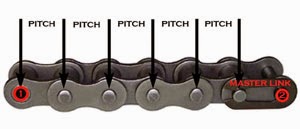Go Kart Chains and Sprockets Tech Tips and Maintenance
Chains and sprockets are a part of every go kart drivetrain. In conjunction with the clutch, these two components transfer the power from the engine to the axle.
Kart Chains
Chain is sized by the pitch (the distance between roller centers). See the chain shown in the picture. The two most common sizes for go karts is #35 and #219. You might also run into #428 chain and sprockets on rental, fleet or concession karts. If you're racing 4-cycle engines, the most common chain is #35. It has a pitch of 3/8" or about 9.5mm. If you're racing 2-cycle engines, the most common chain size is #219 which has a pitch of 0.306" or about 7.8mm. The #428 chain has a pitch of 12.7mm or 0.5".

The main advantage to #35 chain is its strength. #35 chain has larger diameter pins and thicker side plates which allow it to handle more power from the engine. #219 chain on the other hand has the advantage of lighter weight for a given chain length. #219 chain also has longer chain life because it has more pins per inch.
Kart Sprockets
Sprockets are matched to the the size chain you are running. They are sized by the number of teeth. The more teeth your sprocket has, the more engine torque driving the axles is multiplied. On the flip side, however, your engine will have to turn faster to achieve a particular kart speed. Sprockets with more teeth will have a larger diameter. That's where #219 chain has an advantage over #35 chain. For a given sprocket diameter, a #219 sprocket can get more teeth than a #35 sprocket because the distance between the teeth smaller. Sprockets come both in solid or split variants. Split sprockets allow you to change the sprocket without taking apart your axle assembly. Make sure to pay attention to the ground clearance when choosing your sprocket size.
Adjustments and Maintenance
There are two key adjustments you'll want to keep in mind. First, make sure your axle sprocket is lined up perfectly with the engine sprocket. Misalignment will cause loss of power transfer and increased wear on both the chain and sprocket. Second, make sure the the chain tension is set correctly. At the mid-point between the engine sprocket and the axle sprocket, there should be between 1/4" and 3/8" deflection when you push on the chain. Too little deflection means the chain is too tight and too much deflection means the chain is too loose.
Go kart chains don't require a lot of maintenance. Just keep them lubricated periodically with a good graphite-based lubricant. Avoid using oil-based lubricants as they tend to allow dirt and other debris to stick to the chain. Make sure the lube has time to work its way into the rollers before starting your engine. Keep an extra chain or two in your toolbox. Don't let a broken chain shorten your day at the track.
If you are having problems with the chain "jumping" there a few things you should double check. First make sure that if you are using a split sprocket that the two halves are aligned correctly. Usually they have a mark showing where they should be matched. If you broke the chain or resized the chain make sure the link is correct. You also want to make sure the sprocket is installed correctly. A tech tip from a warehouse manager to do this is to install the sprocket but don't tighten it, instead wrap the chain all the way around it first and get it tight - this will get everything straight and in correct alignment, now while you are holding the chain tighten down the sprocket. If these checks don't help, start looking for bent gears or a bent axle.
You can use the quick links below to order sprockets and chains:
Click here for all Go Kart Chains
Click here for #219 Go Kart Sprockets and Chains
Click here for all Go Kart Sprockets
Click here for #35 Go Kart Chains and Sprockets